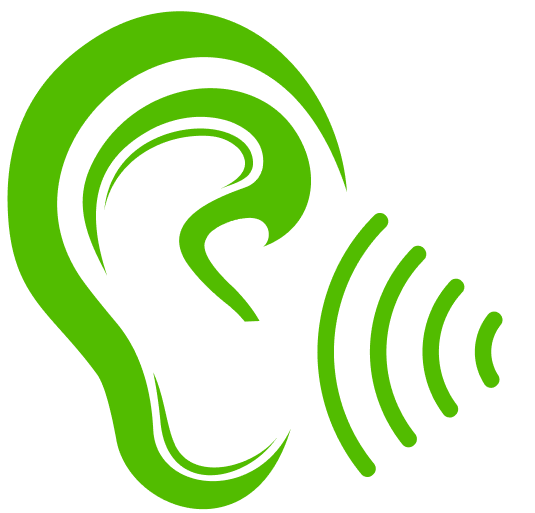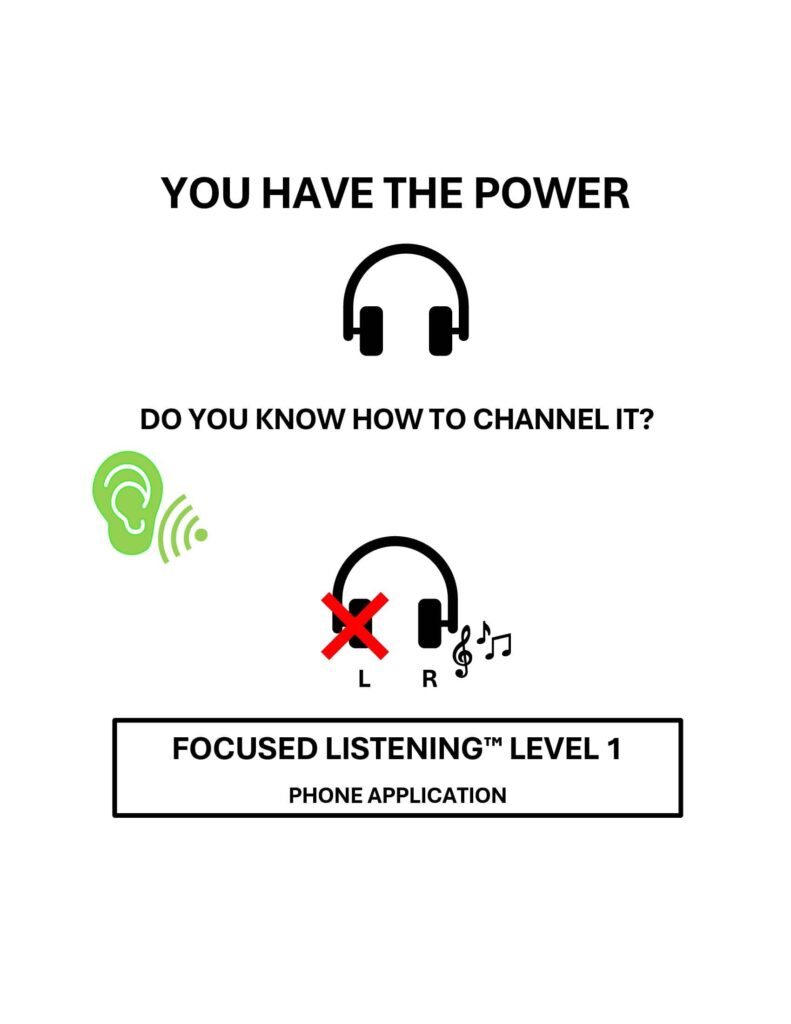
WHAT IS AN AURACLE?

We coined a new word auracle for the modified (left ear channel muted) headphones that improve hearing. Since spectacles (from the Latin spectaculem) improve how things are seen, the parallel instrument to improve how sounds are heard is based in the Latin word auris for ear. The right-eared listening technique was invented by Laurna (a variant of Laura), who likes the echo of her name in auracle.
TO DO FOCUSED LISTENING™ YOU NEED AN AURACLE. SPECTACLES CORRECT VISION — AURACLES CORRECT HEARING!
YOU CAN EASILY MAKE AN AURACLE BY MUFFLING THE LEFT EARPIECE OF ORDINARY HEADPHONES WITH A FOLDED SOCK OR OTHER PAD OF
CLOTH.
Some people prefer to use an earplug but make sure it is the kind attached to a string so the plug can be removed safely and easily at the end of the listening session. You can turn ordinary headphones into an auracle by muffling the left earpiece with a pad of cloth, such as a sock folded against the earpiece and turned inside-out at the ankle to secure it over the earpiece, or by securing a pad of facial tissues to the left earpiece with an elastic band. If the headphones are going to be used binaurally by someone else, muffling doesn’t destroy them. Furthermore, you also may need to use the headphones binaurally to take your own audiograms. It is important to know how you are hearing in each ear, even though the therapy is ONLY for the right ear.
How Do I Use It?
1. Use ONLY over-the-ear headphones.
2. Listen ONLY with the RIGHT ear, with the left ear channel muffled.
3. Never use earbuds. They bring sound too close to the eardrum and middle ear.
4. Avoid headphones with enhanced
bass. Do not use “sound cancelling”
headphones unless you remove the battery.
There may be some advantage to using “studio” or “flat frequency response (FFR)” headphones. However, good results have been achieved with inexpensive headphones (without enhanced bass).
.
Then, What?
USE FOCUSED LISTENING™ TO IMPROVE YOUR LISTENING ABILITY AND TO HAVE MORE ENERGY — LESS FATIGUE.
LISTEN TO CLASSICAL VIOLIN MUSIC WITH ONLY YOUR RIGHT EAR FOR 1 to 2 HOURS PER DAY.
DO NOT LISTEN WITH HEADPHONES FOR LONGER THAN 2 HOURS PER DAY!!! STAY WITHIN THE WINDOW OF HEALING ENERGY.
Most people can listen to healthy sound WITHOUT headphones for unlimited amounts of time. Healthy sound is rich in high frequencies (think in terms of stringed instruments, wood wind instruments) without much bass sound (drums) AND NOT LOUD (trumpets, horns, etc.). Control the volume of your sound source so that bass and loud instruments are at low to moderate volumes.
KEEP A DAILY LOG OF YOUR LISTENING TIMES AND NOTE ANY CHANGES YOU EXPERIENCE WHILE YOU ARE LISTENING OR AFTERWARDS.
YOU SHOULD NOTICE IMPROVEMENTS IN TWO TO THREE WEEKS. HOWEVER, YOU DO NOT NEED TO STOP AT THAT POINT IF YOU FIND THAT REGULAR OR INTERMITTENT USE OF FOCUSED LISTENING™ IS NECESSARY FOR YOU TO MAINTAIN YOUR HEALING.
People benefit from environments rich in higher frequencies of sound. If you do not live in that kind of environment, you can create one by leaving a radio tuned to a music station that does not specialize in low-frequency sound. Think violins regardless of genre — classical, country, folk.
People with painful sensitivity to certain frequencies of sound usually will lose that hypersensitivity after gently and persistently retraining their hearing with a music therapy.
Hearing
Knowledge Is
Healing
Knowledge
People can use Focused Listening™ without understanding why it works. That feature is important for the young and for the disabled and for those who need a mentor to help them use Focused Listening™. However, many people would like to know at least as much about their hearing as they know about their vision. They can learn here about:
- their hearing mechanism, especially the stapedius muscle in the middle ear
- the amount of sound entering through the ear to the brain
- their neurological patterns for feeding sound energy to each half of the brain
- the way sound energy is reaching their whole nervous system and the organs it influences.
Using headphones binaurally (with both ears), except for depression, tends to maintain the person’s present way of hearing, whether it is perfectly ideal or whether it is problematic. Since amplified music sends more energy into the brain and body, it tends to “feel good,” whether or not it is causing harm.
A vast number of people own headphones, most of which are used for listening to music. Few of those people realize the potential power of those headphones to change the body for health or for harm, although such effects are already operating on them. Listening to music with headphones affects the smallest structural muscle in the body. It is located in the middle ear and has a far-reaching affect on the brain and nervous systems. Structural muscles move bone. The stapedius muscles move the third bones of hearing (stapes or stirrup) that transmit sound in the environment entering the ear canals from the middle ear to the inner ear and on into the brain AND THROUGHOUT THE BODY. (Environmental or ambient sound also is received by the body through receptors in the skin, through the skeleton, especially the temporal and mastoid bones, and in soft tissue.) Remarkably little has been known about the effects on the body of sound. Much speculation and fantasy has filled the vacuum. Laurna Tallman’s independent research and discoveries have broken new ground on this scientific frontier.
What about binaural listening with headphones?
To be clear, binaural (both ears) listening with headphones for people with severe right ear problems may not be therapeutic. It may not be healthy, and it may perpetuate or worsen a problem. On the other hand, it may be the best therapy in certain conditions, such as severe depression and it can give an energy boost to people whose ears already work well, depending on the nature of the music and the volume level.
Binaural listening, if the music is high-frequency, not too loud, and listened to for only an hour or two per day can correct mild conditions, such as dyslexia or fatigue, but not as efficiently as Focused Listening™. With binaural listening, left-ear distortions are being reinforced and right ear dominance is not prioritized. This approach was used by Tomatis and by Bérard and has been copied by dozens of other music therapies. But it is unlikely to cure autism and, as Bérard noted, can make schizophrenia worse. Although Bérard did not know about the Tallman Paradigm™, it explains his observation that his AIT program should not be used by schizophrenics.
Binaural listening may be the best approach for moderate to severe depression. Getting an audiogram is very important if depression is suspected! You need to know in which ear the loss of sound energy is occurring in order to choose the best therapeutic method. We talk more about this serious health issue in Levels 2 and 3.
Focused Listening™ reinforces the neural pathways LIKE THOSE OF OF A PERSON WHO IS RIGHT-EAR DOMINANT. Gradually establishing those neural pathways as the dominant ones will also speed up cerebral integration. In doing so, the music therapy may be clearing inflammation in the brain, For the brain and body to function efficiently, right-ear dominant neurology is essential.
Recent studies show that even the “minor” ear conditions, such as ADD and ADHD, are not harmless and reduce life expectancy. Much has been written to rationalize dyslexia as merely an “alternative” learning system. While the effort to protect such learners from stigma is understandable, the facts remain that the condition is not benign. However, it is treatable with properly applied music therapies, even binaural ones, although Focused Listening™ may be the superior approach.